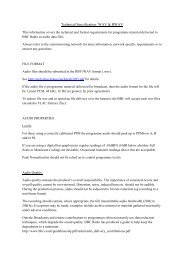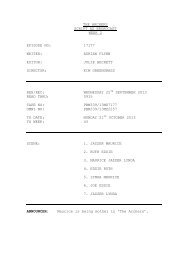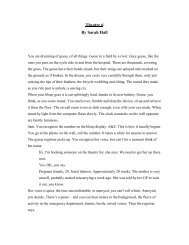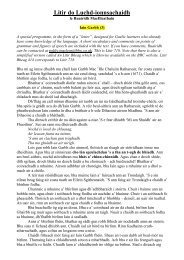50 Great British Inventions - BBC
50 Great British Inventions - BBC
50 Great British Inventions - BBC
You also want an ePaper? Increase the reach of your titles
YUMPU automatically turns print PDFs into web optimized ePapers that Google loves.
A special 24-page ( magazine inspired<br />
by the <strong>BBC</strong>2 season genius of invention<br />
RadioTimes <strong>50</strong> <strong>Great</strong> <strong>British</strong> <strong>Inventions</strong> 00
MICHAEL MOSLEY<br />
A nation founded<br />
on invention<br />
Sir James Dyson once<br />
told me that he believed<br />
part of the reason the<br />
<strong>British</strong> are so good at<br />
inventing things is<br />
because we are an island race. I’m not so<br />
sure I can point to any one particular <strong>British</strong><br />
characteristic that has encouraged such a<br />
great inventing tradition, but our geography<br />
certainly has helped. It created its own<br />
pressures, separated us intellectually as well<br />
as physically from the rest of Europe. It made<br />
our relatively affluent, well-educated nation<br />
turn to science at a time when the rest of the<br />
world did not. It gave us a head start.<br />
The result is that we have an enormous<br />
amount of history that we can draw on for<br />
inspiration. We led the Industrial Revolution,<br />
and I can look back with huge respect at all<br />
those steps in our engineering and inventive<br />
past that make my life today so easy.<br />
That past — which <strong>BBC</strong>2 is celebrating this<br />
year with a season of programmes called<br />
Genius of Invention — can also fuel the next<br />
generation of scientists and inventors. Our<br />
universities are world class, with a great<br />
history of technology behind them. We turn<br />
out a phenomenal number of Nobel Prize<br />
winners, and our heritage has made us a very<br />
open place, ready to embrace talent from<br />
around the world.<br />
But there is a downside. Perhaps because<br />
we are used to getting there first, we constantly<br />
fail to commercialise <strong>British</strong> invention. Tim<br />
Berners-Lee, the father of the worldwide web,<br />
is rightly applauded for giving his invention to<br />
the world — yet on another level it would have<br />
been nice if he could have benefited from his<br />
Have your say<br />
which of the following<br />
<strong>50</strong> inventions, compiled<br />
for RT by a group of <strong>BBC</strong><br />
science experts, is your<br />
favourite? and are there<br />
any from the randomly<br />
displayed list that they’ve<br />
missed out? vote now at<br />
radiotimes.com/inventions<br />
work in the way Google’s founders have done.<br />
Richard Trevithick — the inventor of my choice<br />
in this supplement (see page 7) — is a great<br />
example of a man who doesn’t get the<br />
recognition he deserves because he failed<br />
to commercialise his invention.<br />
Attitudes are changing, and I have<br />
absolutely no doubt that our economic<br />
future lies in tapping into <strong>British</strong><br />
inventiveness. Programmes such<br />
as Dragons’ Den and figures like Steve Jobs<br />
and James Dyson have certainly inspired<br />
my children. They want to make things, but<br />
they also want to sell things. They want to<br />
be entrepreneurs.<br />
We need invention now to help pull us out<br />
of our current morass, and I’m very hopeful<br />
our next generation of inventors is going<br />
to do it. To achieve this, we must reconnect<br />
with a culture of innovation that served these<br />
islands so well in the past: where scientists<br />
and inventors are appreciated, and where<br />
people see things that inspire them and<br />
want to make them even better.<br />
Michael Mosley presents<br />
a new series, The Genius<br />
of Invention, which starts<br />
on <strong>BBC</strong>2 next week<br />
1 Thermos<br />
flask<br />
INvENTED 1892 INvENTOR<br />
SIr JAMES dEwAr<br />
This humble invention was the<br />
brainchild of Sir James Dewar, an<br />
eminent professor of chemistry at<br />
Cambridge and leading light of the<br />
Royal Institution. Dewar didn’t<br />
invent it to keep tea hot on picnics,<br />
but to help his experiments on<br />
cooling gases, like air and oxygen,<br />
to such low temperatures that<br />
they would liquefy.<br />
The flask was actually two flasks,<br />
one inside the other, touching only<br />
where they joined at the top, and<br />
with a vacuum in between. Its<br />
purpose was to keep its contents<br />
either warmer or cooler than the<br />
ambient temperature outside.<br />
Sadly for Dewar he never<br />
patented his invention. When the<br />
German Thermos Company did,<br />
he sued them – and lost. <br />
2 Worldwide web<br />
INvENTED 1989 INvENTOR TIM BErnErS-LEE<br />
DID YOU KNOW?<br />
Berners-lee’s<br />
parents were<br />
Both involved<br />
in the<br />
developMent<br />
of one of the<br />
earliest<br />
CoMputers, the<br />
ferranti Mark 1,<br />
unveiled in 1951.<br />
Not to be confused with the internet, which is a system of<br />
linked computer networks, the worldwide web was invented<br />
by <strong>British</strong> computer scientist Tim Berners-Lee. It was while<br />
working at Cern, the European particle physics lab, that he<br />
wrote a proposal showing how “hypertext” – a way of sharing<br />
information via links – could be married with the internet to<br />
create a system for fellow scientists to share data.<br />
He created the first server in late 1990 and, on 6 August,<br />
1991, the web went live, with the first page explaining how<br />
to search and how to set up a site. One critical innovation<br />
was that web users could link their page to another without<br />
the need for the other user’s approval. And Berners-Lee<br />
gave his invention to the world for free. <br />
3 Lawnmower<br />
INvENTED 1827<br />
INvENTOR EdwIn BEArd BuddIng<br />
What could be more quintessentially <strong>British</strong> than<br />
a perfectly mown lawn in summer? Until inventor<br />
Edwin Beard Budding came up with the lawnmower<br />
in 1827, this was the preserve only of the very rich,<br />
who could afford an army of people to cut their<br />
lawns with scythes. Budding already had a<br />
reputation for inventiveness: he devised a repeating<br />
pistol that predated Samuel Colt’s, a cotton carding<br />
machine of a design that is still used today, and<br />
the first screw-adjusted spanner.<br />
His first mower was 19in wide, had a box that<br />
collected the clippings as they were thrown<br />
forward by the blades and allowed the user<br />
to adjust the height of the cut. It was, at<br />
first, still a fairly exclusive item: Oxford<br />
colleges and the Royal Zoological Society<br />
were among his first customers. But its<br />
popularity spread as more <strong>British</strong> homes<br />
came to have gardens. And because<br />
it made lawns more affordable,<br />
it gave an important boost<br />
to sports that were<br />
played on grass, such<br />
as cricket, rugby<br />
and football. <br />
4 Float glass<br />
InvEnTEd 1959 InvEnTOr AlAstAir Pilkington<br />
When we think of inventions, it’s machines and gadgets that<br />
usually come to mind. But what about all the processes needed<br />
to create and manufacture the materials the modern world is<br />
made of? Take glass: almost all the glass we use today is made<br />
using the “float” process, devised by Alastair Pilkington in 1959.<br />
Molten glass is poured from a furnace onto a shallow bath of<br />
molten tin: the glass floats on the tin, and under its own weight<br />
it spreads out to form a level surface. As it gradually cools on<br />
the tin, the glass is drawn off in a continuous ribbon. This<br />
process made it far easier and cheaper to make high-quality<br />
glass, without the need for grinding and polishing. <br />
2 RadioTimes <strong>50</strong> <strong>Great</strong> <strong>British</strong> <strong>Inventions</strong><br />
RadioTimes <strong>50</strong> <strong>Great</strong> <strong>British</strong> <strong>Inventions</strong><br />
3
4<br />
DID YOU KNOW?<br />
fry’s merged<br />
with cadbury<br />
in 1919, their<br />
assets<br />
combined in a<br />
new holding<br />
firm, the british<br />
cocoa and<br />
chocolate<br />
company.<br />
MeN oN WIRe<br />
engineers at work on<br />
a telegraph poll in hull, 1955<br />
5 Chocolate bar<br />
inventeD 1847 inventor JS FRy & SoNS<br />
The first chocolate bar was created by JS Fry &<br />
Sons of Bristol in 1847. It was sold to the public<br />
as chocolate “delicieux à manger” – delicious to<br />
eat – because, until this point, chocolate had<br />
been exclusively consumed as a drink.<br />
Fry’s company, originally an apothecary, had<br />
been selling drinking chocolate since the 17<strong>50</strong>s,<br />
but the breakthrough came about when the<br />
company decided to combine cocoa powder<br />
with sugar and cocoa butter to make a product<br />
that could be moulded into a solid bar. It was<br />
the cocoa butter – the oil extracted from cocoa<br />
beans – that was the key: it’s melting point<br />
matches the temperature of the human body,<br />
so it stays solid at room temperature but<br />
melts in the mouth.<br />
When other chocolate-makers copied the<br />
bar, Fry’s upped the ante by introducing the<br />
first cream-filled bar in 1866. More<br />
innovations followed and by the First World<br />
War, Fry’s was one of the largest employers<br />
in Bristol. <br />
6 Electric telegraph<br />
inventeD 1837 inventorS CHaRLeS WHeaTSToNe<br />
aNd WILLIaM CooKe<br />
The electric telegraph was a world-shrinking technology<br />
like no other. The first working system was demonstrated in<br />
1837 by the <strong>British</strong> physicist Charles Wheatstone and<br />
his young engineer partner, William Cooke. The first<br />
fully operational telegraph ran from 1839 between<br />
Paddington and West Drayton railway stations in<br />
London, but at first it was slow to catch on. That is<br />
until New Year’s Day, 1845. John Tawell, who had just<br />
murdered a lady of his acquaintance, jumped on a train<br />
at Slough and made his getaway. But when the police<br />
arrived, the station clerk was able to telegraph Paddington,<br />
where Tawell was arrested when his train pulled in.<br />
It was a sensation, and from here on the technology<br />
exploded. Morse Code made it efficient; telegraph cables<br />
were soon everywhere – in 1858 the first transatlantic cable<br />
was laid – and by the end of the century there were more<br />
than 1<strong>50</strong>,000 miles of cable connecting the globe. <br />
7 Modern fire<br />
extinguisher<br />
inventeD 1818 inventor<br />
GeoRGe WILLIaM MaNBy<br />
The first recorded fire extinguisher<br />
was invented and patented by a<br />
London chemist called Ambrose<br />
Godfrey in 1723. Godfrey’s invention<br />
was perhaps motivated by his line<br />
of business – he was a successful<br />
manufacturer of the highly flammable<br />
chemical phosphorus. His gadget rather<br />
surprisingly used gunpowder to scatter<br />
the fire-extinguishing liquid, but there’s<br />
at least one contemporaneous newspaper<br />
report of its success in putting out a blaze.<br />
The first modern extinguisher, the<br />
“Extincteur”, was invented by naval captain<br />
George William Manby in 1818. It’s said he<br />
was inspired by the sight of<br />
firemen struggling to fight<br />
the flames on the top floors<br />
of a house fire in Edinburgh.<br />
His solution was a portable<br />
copper cask containing three<br />
to four gallons of potassium<br />
carbonate, which was<br />
dispersed by compressed<br />
air via a stopcock. <br />
DID YOU KNOW?<br />
george william<br />
manby is most<br />
famous for his<br />
manby mortar,<br />
which fired<br />
a line to<br />
struggling<br />
ships off shore,<br />
enabling people<br />
to be rescued.<br />
8 Light bulb<br />
INVeNTed 1880 INVeNToR Joseph swan<br />
Cheap and reliable electric lighting was a holy<br />
grail for 19th-century inventors. But didn’t<br />
Thomas Edison get there first? No! He was<br />
beaten to it by Britain’s very own Joseph<br />
Swan, working out of his private lab at his<br />
house in Gateshead. Swan got his patent –<br />
and started manufacturing and selling his<br />
bulbs – in 1880. He developed a tiny filament<br />
that used specially treated cotton, and set<br />
it inside an oxygen-free vacuum so that it<br />
wouldn’t catch fire when it glowed white-hot.<br />
Swan’s first bulbs lasted little more than<br />
12 hours but, unlike gas lamps, there was no<br />
flame or dirty smoke and they soon caught<br />
on. The impresario Richard d’Oyly Carte<br />
seized the opportunity to make his new<br />
Savoy Theatre in London stand out – and<br />
when it opened the following year it was the<br />
first public building in the world to be lit<br />
electrically throughout. D’Oyly Carte even<br />
took to the stage himself – holding a glowing<br />
bulb aloft, he ceremoniously broke it in front<br />
of the audience to prove it was safe. <br />
Coming soon… highlights<br />
of the <strong>BBC</strong>2 season<br />
throughout 2013<br />
Why the Industrial Revolution<br />
Happened Here Monday 9.30pm<br />
investigating why Britain became the<br />
world’s most powerful industrial nation.<br />
The Flying Scotsman at 90<br />
marking the anniversary of the great<br />
london—edinburgh steam train.<br />
The Railway: Keeping Britain<br />
on Track Behind the scenes of<br />
the nation’s rail network.<br />
Murder on the Victorian Railway<br />
investigating the first murder<br />
on a passenger train.<br />
Newton: the Last Magician<br />
the life and work of the physicist,<br />
mathematician, astronomer.<br />
Speed King the life and career of<br />
record-breaking Donald campbell.<br />
Turner: Man of Iron<br />
examining the artist’s fascination<br />
with science and technology.<br />
Science Britannica Brian cox<br />
celebrates <strong>British</strong> science and<br />
re-creates his heroes’ experiments.<br />
The Genius of Josiah Wedgwood<br />
an Wilson tells the story of the man<br />
who revolutionised <strong>British</strong> ceramics.<br />
Challenger: Final Flight<br />
Fact-based drama about the<br />
1986 space shuttle disaster.<br />
Horizon: Reinventing Invention<br />
liz Bonnin reveals the ideas<br />
and technologies set to<br />
transform our lives.<br />
Stephen Fry’s Planet<br />
Invention Fry explores<br />
the triumph of consumer<br />
capitalism and mass<br />
production.<br />
The Hairy Bikers:<br />
Rebuilding<br />
Industrial<br />
Britain<br />
Si and Dave<br />
visit heritage<br />
groups<br />
restoring old<br />
mechanical<br />
wonders.<br />
RadioTimes <strong>50</strong> <strong>Great</strong> <strong>British</strong> <strong>Inventions</strong> RadioTimes <strong>50</strong> <strong>Great</strong> <strong>British</strong> <strong>Inventions</strong><br />
*Some programme titleS may change<br />
5
9 Pneumatic<br />
tyre<br />
Invented 1887<br />
Inventor John boyd dunlop<br />
In 1845, railway engineer Robert William<br />
Thomson patented the world’s first pneumatic<br />
tyres at the age of just 23. He demonstrated his<br />
“aerial wheels” – a belt of air-filled rubber fitted inside<br />
a leather casing – on horse-drawn carriages in London’s<br />
Regent’s Park. Unfortunately there was no real market for<br />
them – the automobile and bicycle hadn’t been invented yet.<br />
Forty years later, Belfast vet John Boyd Dunlop, unaware of<br />
Thomson’s earlier invention, came up with pneumatic tyres to<br />
stop his son getting headaches riding his bumpy tricycle. This<br />
time around, the invention coincided with the new bicycle<br />
craze. Dunlop persuaded the captain of the Belfast Cruisers<br />
Cycling Club to try his tyres: when he chalked up a string of<br />
racing victories, the success of the invention was assured. <br />
10 Catseye<br />
Invented 1933 Inventor pERcy shaw<br />
Percy Shaw was a Yorkshire road contractor who devised the Catseye<br />
reflector in 1933. He liked to claim that inspiration struck when he<br />
was driving home from the pub on a foggy night and saw the<br />
reflection of his headlights in the eyes of a cat, sitting by the road.<br />
The lens that reflects light back at its source had in fact been created<br />
by another <strong>British</strong> inventor, Richard Hollins Murray, a few years<br />
earlier. Shaw’s masterstroke was to wrap this lens in a flexible rubber<br />
casing and set it into the centre of the road. (In the Second World<br />
War, the Ministry of Transport realised that Catseyes were the<br />
perfect way to keep roads safely lit at night during<br />
blackouts.) Shaw’s Catseye was voted the greatest<br />
design of the 20th century. <br />
11 Carbon fibre<br />
Invented 1963<br />
Inventors Royal aiRcRaft EstablishmEnt EnginEERs<br />
This marvellous material is one of many inventions developed by the<br />
military that are incredibly useful for us all. In 1963, engineers at the<br />
Royal Aircraft Establishment’s research station at Farnborough worked<br />
out how to reinforce plastics with carbon filaments to produce a material<br />
that was strong, lightweight and could be mass-produced.<br />
Early on, there were setbacks – carbon fibre was used for the turbine<br />
blades for the Rolls-Royce RB-211 jet engine, but the lightweight blades<br />
just weren’t strong enough. They failed the bird-strike test – they<br />
shattered when a frozen chicken was fired into them at high<br />
speed – and the engine had to be scrapped at huge cost.<br />
But the inventors at Farnborough found other<br />
uses for the material and today the material<br />
has thousands of applications in<br />
boats, cars, motorbikes,<br />
sports equipment, and<br />
even in the fuselages<br />
of jumbo jets. <br />
6 RadioTimes <strong>50</strong> <strong>Great</strong> <strong>British</strong> <strong>Inventions</strong><br />
DID YOU KNOW?<br />
the rae team<br />
improved upon<br />
experiments<br />
with carbon<br />
fibre<br />
previously<br />
conducted by<br />
american and<br />
japanese<br />
researchers.<br />
12 Disc<br />
brakes<br />
Invented 1902 Inventor<br />
fREdERick william<br />
lanchEstER<br />
Frederick William Lanchester<br />
was one of Britain’s first<br />
motorcar designers and<br />
manufacturers. Disc brakes<br />
employ brake pads that squeeze<br />
each side of the rotor turning a<br />
wheel, and they were fitted to the cars<br />
made by his Lanchester Engine<br />
Company in Birmingham. They were<br />
quicker to cool down and to dry out than<br />
the drum brakes used in most cars at the time.<br />
Sadly, Lanchester lacked the money and<br />
business acumen to develop them properly.<br />
He made his brakes using copper, which wore<br />
down too quickly, and they didn’t catch on.<br />
It was only in the 19<strong>50</strong>s, after Lanchester had<br />
died, that car makers decided to use stronger<br />
and more durable materials, like cast iron.<br />
Today, almost all cars use his invention. <br />
michaEl moslEy<br />
13 Steam engine<br />
Invented 1801<br />
Inventor RichaRd tREvithick<br />
the high-pressure steam engine<br />
is the most extraordinary invention<br />
of all time. It made the Industrial<br />
revolution possible; it made the<br />
modern world possible.<br />
For most of history, empires ran<br />
on one thing: slave power. during<br />
richard trevithick’s time we had wind power and<br />
water power to a very limited extent, but it wasn’t<br />
portable: you had to build your generator next to a<br />
stream if you wanted to tap into it. What trevithick<br />
did with high-pressure steam was to take power, in<br />
this case in the form of coal, and turn it into<br />
workable energy.<br />
everybody believes that James Watt was<br />
responsible for the modern engine, but he wasn’t.<br />
What he did was improve on another invention<br />
called the atmospheric engine (devised by thomas<br />
newcomen in 1712). It was the size of a house,<br />
could never have been portable and operated<br />
on a completely different principle to the modern<br />
steam engine. It could pump water, but basically<br />
it was dead-end technology.<br />
trevithick’s invention, however, would become<br />
the father of the steam train and the father of<br />
portable steam power. on Christmas eve 1801 he<br />
tested a steam car, known as the Puffing Devil, which<br />
successfully climbed Camborne Hill in Cornwall.<br />
In doing so, trevithick became the first person<br />
to power a piston using high-pressure steam. It had<br />
been attempted for 2,000 years, but every time<br />
people had tried, it had blown up and usually killed<br />
whoever was nearby. trevithick managed it: he<br />
had the materials and the know-how, and his<br />
invention reduced the steam engine from the size<br />
of a house to the size of a modern car. He liberated<br />
power, and in doing so transformed the world. <br />
Michael Mosley’s four-part series, The Genius<br />
of Invention, begins next week on <strong>BBC</strong>2<br />
7
8<br />
14 Soda water<br />
Invented 1772<br />
Inventor Joseph priestley<br />
Joseph Priestley was an 18th-century<br />
clergyman and scientist fascinated<br />
by chemistry, electricity, optics and<br />
many other subjects. As well as being<br />
possibly the first person to isolate<br />
oxygen, he invented carbonated water<br />
(later known as soda water) when he<br />
suspended a bowl of water above a beer vat at<br />
a brewery near his home in Leeds. The carbon dioxide gas<br />
given off by the fermenting vat was known as “fixed air”. Being<br />
heavier than air, it stayed above the vat rather than dispersing.<br />
Priestley found he could dissolve the gas in the water and that<br />
it made a refreshing drink – of a kind that met the approval of<br />
his clean-living, religious-minded friends.<br />
In 1772, he published a description of how to make carbonated<br />
water, using sulphuric acid and chalk, and just a few years later<br />
the Swiss fizzy drinks pioneer Johann Schweppe set up his<br />
Schweppes drinks company in London to manufacture<br />
carbonated mineral water using Priestley’s method. <br />
15 Hypodermic syringe<br />
Invented 1853 Inventor alexander wood<br />
Alexander Wood was an eminent Edinburgh doctor who<br />
co-invented the first true hypodermic syringe. The syringe itself<br />
had been known since ancient times; and the hollow needle had<br />
been invented a few years before, but Wood’s innovation was to<br />
combine them into a means of penetrating the skin of his patients<br />
to deliver drugs intravenously without having to cut the skin first.<br />
It is said he found inspiration in the sting of the honeybee.<br />
He initially used the syringe for morphia and other opiates<br />
– and he used a glass syringe so he could see how much medicine<br />
had been used. He also later came up with the idea of adding a<br />
scale. This was a great breakthrough in anaesthetics, and helped<br />
advance the procedure of giving blood transfusions. <br />
16 Reflecting<br />
telescope<br />
invented 1668 inventor isaac newton<br />
The first known successful reflecting<br />
telescope was built in 1668 by a man who is<br />
remembered by most people for identifying<br />
the effects of gravity. Sir Isaac Newton, then<br />
a fellow at Trinity College, Cambridge, took<br />
the idea of a reflecting telescope, which had<br />
been around for decades, and turned it into<br />
reality. It gives as much credence to his<br />
engineering skills as to his scientific mind.<br />
He built it to prove his theory that white<br />
light, the visible part of the electromagnetic<br />
spectrum, is made up of many different<br />
colours. Newton’s design consisted of a<br />
spherical-shaped mirror, made of a coppertin<br />
alloy, above which he placed a second flat<br />
mirror at a 45 degree angle, which reflected<br />
the light into an eyepiece mounted on the side<br />
of the telescope. This huge leap forward in<br />
telescope technology made astronomical<br />
observation much more accurate. <br />
RadioTimes <strong>50</strong> <strong>Great</strong> <strong>British</strong> <strong>Inventions</strong> RadioTimes <strong>50</strong> <strong>Great</strong> <strong>British</strong> <strong>Inventions</strong><br />
DID YOU KNOW?<br />
the 36in yapp<br />
telescope,<br />
pictured here,<br />
was one of the<br />
largest in the<br />
world when it<br />
opened at the<br />
greenwich<br />
observatory<br />
in 1934.<br />
17 Collapsible<br />
baby buggy<br />
Invented 1965 Inventor owen Maclaren<br />
In 1965, engineer Owen Maclaren was delighted to<br />
be visited by his daughter and his first grandchild,<br />
but watched with frustration as his daughter struggled<br />
with an unwieldy pushchair. Fortunately for her – and<br />
for new parents ever since – Maclaren had been the<br />
man in the Second World War who helped design the<br />
folding undercarriage for the Spitfire.<br />
Now he decided to apply his<br />
knowledge to the pram problem.<br />
Within two years he had designed,<br />
manufactured and launched the<br />
first collapsible buggy, the classic<br />
B-01, made using lightweight<br />
aluminium tubing. It folded<br />
up into something no<br />
bigger than a large<br />
umbrella. Today,<br />
the most modern<br />
version is sold in<br />
more than <strong>50</strong><br />
countries. <br />
9
00 10<br />
18 Steam turbine<br />
Invented 1884 Inventor Charles Parsons<br />
After the invention of the electrical motor<br />
– which transforms rotation into electrical<br />
power – the next step was to find a device<br />
to drive it. Piston engines vibrated too<br />
violently, so the steam turbine, invented<br />
by Newcastle-based engineer Charles<br />
Parsons in 1884, was the answer.<br />
The turbine is like a windmill – steam<br />
blasts the turbine blades and turns them<br />
round. What Parsons came up with was<br />
a means of extracting every last ounce of<br />
19 Marine chronometer<br />
Invented 1761 Inventor John harrIson 21<br />
Accurate navigation at sea has always<br />
been critically important but, until the<br />
invention of the marine chronometer, it<br />
was extremely difficult, if not impossible.<br />
Latitude was straightforward to measure;<br />
the problem was longitude. In 1714,<br />
some 200 years after sailing ships<br />
had first circumnavigated the<br />
world, the <strong>British</strong> government<br />
announced a £20,000 prize<br />
– worth almost £3m today<br />
– for anyone who could<br />
solve the problem.<br />
The key to it was<br />
making a clock that<br />
could somehow keep<br />
power from the steam. He made the<br />
gaps between the blades very small so<br />
that the steam would accelerate through<br />
the turbine. He also realised you could<br />
channel the steam through multiple sets<br />
of blades in sequence, each one capturing<br />
the steam from the one before. Three<br />
quarters of the world’s power stations<br />
still use steam. Whether steam-powered<br />
or not, every station uses the theory<br />
behind Parsons’s innovation. <br />
accurate time despite being pitched<br />
around by wind and waves and exposed<br />
to great variations in temperature and<br />
humidity. John Harrison, a self-taught<br />
clockmaker, devoted his life to the task.<br />
He began building his first attempt in<br />
1730, but 30 years went by before he<br />
cracked it. The H4 timepiece lost just five<br />
seconds between England and Jamaica<br />
and contained numerous horological<br />
innovations. After lengthy disputes with<br />
the Board of Longitude, Harrison finally<br />
got his reward in 1773. His clocks were<br />
carried by the likes of James Cook and<br />
William Bligh, and safe long-distance<br />
travel was now possible. <br />
DID YOU KNOW?<br />
the turbinia<br />
(1894), the first<br />
ship powered by<br />
a steam tUrbine,<br />
was the fastest<br />
in the world at<br />
the time. see it<br />
at newCastle’s<br />
disCovery<br />
mUseUm.<br />
RadioTimes <strong>50</strong> <strong>Great</strong> <strong>British</strong> <strong>Inventions</strong><br />
20 Synthetic<br />
dye<br />
Invented 1856<br />
Inventor WIllIam PerkIn<br />
In 1856, William Perkin was a precocious<br />
18-year-old studying at the Royal College of<br />
Chemistry when he discovered how to make<br />
the world’s first synthetic dye – mauveine.<br />
The search for how to make synthetics was<br />
at the cutting edge of chemistry at the time,<br />
and Perkin was assisting his professor’s hunt<br />
for an artificial way to make the anti-malarial drug<br />
quinine. Working in his makeshift lab at home one<br />
day during the university holidays, he was using<br />
alcohol to clean out some chemical residue<br />
from a flask when he suddenly saw an<br />
intense purple colour<br />
appear. At the time, dyes<br />
were made from natural<br />
extracts, and were<br />
expensive and faded easily.<br />
Purple came only from the<br />
glands of particular species of<br />
molluscs and was among the<br />
priciest. Perkin worked out how<br />
to reproduce his new colour,<br />
then, keeping it secret from<br />
his professor, he patented<br />
the method and set up<br />
a company to produce it.<br />
Mauve, as it came to be<br />
known, and other synthetic dyes that<br />
followed it transformed the fashion and<br />
the textile industry. And the chemistry<br />
of dyes would have many uses in<br />
medicine, too. <br />
Hip replacement<br />
Invented 1962 Inventor John Charnley<br />
<strong>British</strong> surgeon Sir John Charnley<br />
pioneered the idea that a human hip<br />
joint could be replaced. He designed the<br />
joint and, in 1962, performed the first<br />
successful hip-replacement operation,<br />
at Wrightington Hospital in Lancashire.<br />
Charnley’s design used a femoral stem<br />
and ball made of steel and a hip socket<br />
made of Teflon – later replaced with<br />
harder-wearing polyethylene. Both<br />
parts were glued to the bone using<br />
an acrylic bone cement.<br />
Charnley also introduced important<br />
new improvements to surgical<br />
DID YOU KNOW?<br />
it was said that<br />
the Grand Union<br />
Canal woUld<br />
ChanGe ColoUr<br />
dependinG on<br />
what perkin<br />
was workinG on<br />
in his nearby<br />
west london<br />
dyeworks.<br />
procedure to reduce the chances of<br />
infection: clean air enclosures, suits<br />
for the surgical team that covered their<br />
entire bodies, and a system of sterile<br />
instrument trays. He also taught<br />
surgeons from all over the world.<br />
Although many improvements have<br />
been made since – to the design of the<br />
joint, the surgical method and the ways<br />
of fixing the replacement joint to the<br />
bone – Charnley set the standard.<br />
Today, 80,000 hip replacements are<br />
performed in Britain each year, and<br />
almost a million a year worldwide. <br />
dan snoW<br />
22 Passenger<br />
railway<br />
Invented 1825<br />
Inventor GeorGe stePhenson<br />
one of my favourite <strong>British</strong><br />
innovations is George Stephenson’s<br />
passenger railway. Stephenson’s<br />
parents were illiterate, his mother<br />
dying of tB when he was a child<br />
and his father later blinded in an<br />
industrial accident. It was a<br />
remarkable background for a man who would<br />
forge a communications revolution.<br />
While working as a miner, Stephenson enrolled<br />
in night school where he learnt to read and write,<br />
at age 18. He established an aptitude as a mechanic<br />
and was allowed to build machines at his colliery.<br />
At the time, carts on tracks, pulled by horses, were<br />
used to take coal from the many collieries around<br />
newcastle to the tyne, from where it could be<br />
exported by ship. Stephenson started to innovate.<br />
He improved the design of cast-iron rails to<br />
strengthen them, but above all he used steam<br />
engines to replace horse power.<br />
Machines that harnessed the power of steam<br />
to push, lift or pull had been around for a while;<br />
Stephenson improved them and developed<br />
workable solutions to ensure that rather than<br />
remaining static, these steam engines could<br />
actually run on tracks. the result was a rapid<br />
succession of world firsts: the first “flanged-wheel<br />
adhesion locomotive”. the first trackway or railway<br />
using only locomotives — no horses at all. the first<br />
purpose-built passenger car, which ran on the<br />
world’s first regular passenger-carrying railway, the<br />
Stockton and darlington. the world’s first intercity<br />
railway, between Liverpool and Manchester.<br />
Stephenson’s system of train coupling became<br />
the european standard and his chosen gauge,<br />
or distance between the two rails, of 4ft 8 1 /2in<br />
(1.435m) has become the world’s standard gauge,<br />
adopted nearly universally. We are still carried<br />
along by the revolution that he began. <br />
Locomotion: Dan Snow’s History of Railways<br />
starts on Tuesday at 9.00pm on <strong>BBC</strong>2<br />
11
12<br />
23 Telephone<br />
patented 1876<br />
Inventor alexander GraHam bell<br />
The telephone is a classic example of how<br />
inventions are often the culmination of work<br />
done by many individuals, sharing and borrowing<br />
each other’s ideas. What’s for sure is that<br />
Edinburgh-born Alexander Graham Bell<br />
patented his telephone model in 1876, filing<br />
his patent just hours before a rival inventor.<br />
The telephone came about thanks to the<br />
discovery that a thin metal sheet vibrating in<br />
an electromagnetic field produces an electrical<br />
waveform that corresponds to the vibration<br />
and can be acoustically reproduced.<br />
It’s also pretty likely that Bell made the first<br />
telephone call: “Mr Watson, come here – I want<br />
to see you,” he barked down the phone to his<br />
assistant in the next room. They first publicly<br />
demonstrated their invention at the Centennial<br />
Exhibition in Philadelphia in 1876, and made<br />
their first long-distance call – over ten miles,<br />
between their respective homes in Canada<br />
– a month later. In 1877, Bell set up the Bell<br />
Telephone Company, and 1<strong>50</strong>,000 households<br />
in the US had telephones within a decade. <br />
24 Toothbrush<br />
Invented c. 1770 Inventor William addis<br />
William Addis was a rag trader who got caught up in<br />
a riot in 1770 and was sent to Newgate Prison. While<br />
there, and with time on his hands, he felt that the way<br />
most people were cleaning their teeth, which was to rub<br />
soot and salt over them with a rag, could be improved<br />
on. Possibly inspired by the design of a broom, he saved<br />
a small animal bone left over from a meal and drilled<br />
small holes in it. Then he obtained some bristles, tied<br />
them in small tufts and poked them through the holes.<br />
He glued it all together and – hey presto – a toothbrush.<br />
After his release, Addis set up a business in 1780 to<br />
make what became the world’s first mass-produced<br />
toothbrushes. They made him very rich. Cheap brushes<br />
used pig bristle; more expensive ones badger hair. His<br />
company, Wisdom Toothbrushes, is still going strong<br />
today, though it now uses plastic and nylon. <br />
25 Linoleum<br />
Invented 1860 Inventor Frederick Walton<br />
DID YOU KNOW?<br />
Bell’s<br />
industrious<br />
mind was also<br />
responsiBle<br />
for the<br />
loudspeaker<br />
(1876) and the<br />
forerunner of<br />
the metal<br />
detector (1881)<br />
The idea for Frederick Walton’s wipe-clean floor covering came<br />
to him around 1855, when he noticed that a rubbery, flexible skin<br />
of solidified linseed oil had formed on a can of oil-based paint.<br />
He was fascinated by the thought that linseed oil might be made<br />
into a waterproof material to rival expensive India rubber.<br />
After trying to produce and sell a varnish product, he realised<br />
that if he could apply the varnish to a backing himself, he could<br />
sell flooring directly – cue linoleum.<br />
For almost a century, until cheaper vinyl flooring became<br />
popular in the 1960s, linoleum was the ideal material for<br />
hallways, passages and kitchens: natural, hygienic and, in its<br />
more expensive “inlaid” versions, even beautiful. <br />
26 Television<br />
Invented 1925 Inventor JoHn loGie baird<br />
It’s hard to credit just one person with the invention of<br />
television, but it’s indisputable that John Logie Baird was<br />
the first to transmit moving pictures. In October 1925, he<br />
transmitted a greyscale image of ventriloquist’s dummy Stooky<br />
Bill. He publicly demonstrated his system the following January<br />
and, in 1928, broadcast the first transatlantic television signal,<br />
between London and New York.<br />
But his system ultimately failed. It was mechanical, using a<br />
rotating disc embedded with lenses, one per line, to scan the<br />
image. A rival system – scanning purely electronically, with no<br />
moving parts – was being developed at the same time and was<br />
deemed more reliable and, with far more lines per picture, visibly<br />
superior. Baird, it was said at the time, was “doomed to be the<br />
man who sows the seed but does not reap the harvest”. <br />
27 Automatic kettle<br />
Invented 1955 Inventor Peter Hobbs<br />
The automatic kettle – one that switches itself off when the<br />
water reaches boiling point – was the brainchild of Peter<br />
Hobbs, one of the two founding members of appliance<br />
company Russell Hobbs. (He had previously invented the<br />
world’s first coffee percolator.)<br />
Hobbs’s 1955 K1 kettle had at its heart a simple piece<br />
of technology – the bimetallic strip. This acted like an internal<br />
switch. It was made from two strips of different metals –<br />
usually steel and copper – joined together along their length;<br />
the two metals were chosen because of the difference in their<br />
rate of expansion when heated. As the water boiled, the<br />
steam was funnelled past the bimetallic strip and, as the two<br />
metals expanded at different rates, the combined strip would<br />
bend, breaking a circuit and switching off the kettle. <br />
RadioTimes <strong>50</strong> <strong>Great</strong> <strong>British</strong> <strong>Inventions</strong> 13
29 Military tank<br />
Invented 1914 Inventor ernest swInton<br />
In November 1914, the <strong>British</strong> Army was<br />
using crawler tractors to pull artillery on the<br />
Western Front, when Britain’s official war<br />
correspondent, Ernest Swinton, saw them in<br />
action and realised that they could perhaps be<br />
adapted into bullet-proof and power-driven<br />
offensive weapons that could storm the enemy<br />
lines and take out their guns.<br />
The idea was taken up and “landships” were<br />
developed: the “tank” description was meant<br />
to shield their true purpose from enemy spies.<br />
Because it was the Royal Navy rather than the<br />
Army that first developed them, naval terms<br />
28 Glider<br />
Invented 1804 Inventor george cayley<br />
One of the greatest inventors in the field of aviation<br />
was Yorkshireman George Cayley. The first-ever<br />
sustained manned glider flight was made in a craft<br />
of his design at Brompton Dale in 1853. (Cayley also<br />
invented the tension-spoked wheel – see page 17.)<br />
Cayley first designed an unmanned glider in 1804,<br />
and he was the first to move away from the idea that<br />
a man-made flying machine must have wings that<br />
flapped like a bird’s. Instead, he laid down the concept<br />
of a fixed-wing aircraft, subject to the forces of weight,<br />
lift, drag and thrust, for which he became known as the<br />
father of aeronautics. His first pilot is unknown, but it<br />
may have been his 12-year-old grandson, also George. <br />
were used for some of its parts, hence terms<br />
such as the “hatch” and “turret”.<br />
The first proper tank battle took place at<br />
Cambrai, France, in November 1917, when<br />
some 400 tanks penetrated almost seven miles<br />
behind the front lines, but they weren’t<br />
supported by infantry and soon had to retreat.<br />
These tanks had the capability to climb a<br />
five-foot obstacle, span a five-foot trench, were<br />
resistant to small arms fire and could travel<br />
at 4mph. Although the tank helped end the<br />
stalemate of trench warfare, it came too late to<br />
have much impact on the First World War. <br />
DID YOU KNOW?<br />
george cayley<br />
applied his<br />
genius to many<br />
fields. his ideas<br />
included<br />
an internal<br />
combustion<br />
engine that was<br />
powered by<br />
gunpowder.<br />
31 Jet engine<br />
Invented 1937 Inventor Frank whIttle<br />
Frank Whittle was a 24-year-old<br />
RAF fighter pilot in 1930 when he<br />
patented a new kind of aircraft<br />
engine – the turbojet.<br />
Whittle’s new design had<br />
no propeller and no pistons,<br />
using a gas turbine instead.<br />
With a rotating turbine and<br />
air compressor – and<br />
powered by thrust alone<br />
from the back – his new<br />
design was so radical that<br />
the military wouldn’t<br />
fund it, nor would any<br />
manufacturers.<br />
However, in 1937<br />
Whittle found a few<br />
private backers. After<br />
two more years of<br />
development, it was<br />
reliable enough for the<br />
Air Ministry, and on<br />
5 May 1941 at RAF<br />
Cranwell in Lincolnshire,<br />
a 17-minute test flight went<br />
ahead. It was a revolution. <br />
30 Modern torpedo<br />
Invented 1866 Inventor robert whItehead<br />
It was Giovanni Luppis, an officer in the army of the<br />
Austrian empire, who first came up with the idea of<br />
a self-propelled anti-ship weapon, but it was the <strong>British</strong><br />
engineer Robert Whitehead who really made Luppis’s<br />
concept work.<br />
Whitehead was working for the Austrian navy<br />
when Luppis met him and suggested his idea for a<br />
prototype “coast saver” that used a clockwork motor to<br />
traverse the surface of the water and that was steered by<br />
ropes from the land. Whitehead was captivated by the idea,<br />
though didn’t think much of Luppis’s designs.<br />
Over the next two years he came up with his own design<br />
for a “mineship” – a torpedo launched from a ship in an<br />
underwater tube, powered by compressed air and with an<br />
internal mechanism of his own invention that adjusted itself<br />
to stay at a constant depth. He presented it to the Austrian<br />
navy in 1866, improved the range, speed and accuracy and<br />
had a factory making and selling them worldwide.<br />
The first ship to be sunk by Whitehead’s invention was<br />
the Turkish steamer Intibah in 1878, after being hit by a<br />
torpedo launched from a Russian warship. <br />
14 00 RadioTimes <strong>50</strong> <strong>Great</strong> <strong>British</strong> <strong>Inventions</strong><br />
RadioTimes <strong>50</strong> <strong>Great</strong> <strong>British</strong> <strong>Inventions</strong><br />
15
32 Safety bicycle<br />
Invented 1885 Inventor John Kemp Starley<br />
The bicycle as we know it today was originally developed<br />
as the “safety bicycle”, because other bikes at the time were<br />
extremely dangerous. Riders of the penny-farthing perched<br />
above a huge front wheel, steered indirectly using the tiny<br />
back wheel, and couldn’t touch the ground with their<br />
feet; only a few daring young men would go near<br />
them. The key to the new bicycle was the chain<br />
drive, which meant you could still go fast even<br />
though both wheels were the same size.<br />
Together with front-wheel steering and<br />
back-wheel drive, this made it much more<br />
stable and easier to control. The safety<br />
bicycle was perfected by Coventry<br />
engineer John Kemp Starley, who in<br />
1885 exhibited the Rover (right): the first<br />
recognisably modern bicycle. Light and<br />
cheap, it caught on quickly and brought<br />
cycling to the masses. For most people,<br />
and women in particular, it was arguably<br />
the most liberating invention of all time. <br />
33 Wind-up radio<br />
Invented 1991<br />
Inventor Trevor Baylis<br />
In 1991, Trevor Baylis saw a television<br />
programme about Aids in Africa that<br />
said one way to stop its spread was for<br />
people to hear educational information<br />
on the radio. So Baylis designed one<br />
that needed no batteries, running off<br />
an internal generator powered by a<br />
mainspring wound by a hand crank.<br />
It really took off when he displayed<br />
it on Tomorrow’s World in 1994. In<br />
1996, his Freeplay radio was awarded<br />
the <strong>BBC</strong> Design Award, and Baylis<br />
was able to demonstrate it to Nelson<br />
Mandela. Since then, the radio has<br />
been distributed all over Africa. <br />
34 Cement<br />
Invented 1824 Inventor JoSeph aSpdIn<br />
In 1824, Leeds bricklayer Joseph Aspdin invented and patented<br />
a method of making what he called Portland Cement – the type<br />
that’s most widely used today. The process involved burning<br />
limestone, mixing it with clay and burning it again; the burning<br />
produced a much stronger cement than just mixing limestone<br />
and clay. Aspdin called it “Portland” as he claimed the set mortar<br />
resembled the best limestone quarried from Portland in Dorset.<br />
However, to make it he needed a ready supply of limestone,<br />
and to acquire it he even took to levering up entire paving<br />
blocks at night – which twice landed him in court. His son,<br />
William, moved the business to north-east Kent, where there<br />
were limitless supplies of limestone. William also tweaked the<br />
formula, using more limestone and a higher burning temperature<br />
to produce cement that set more slowly, but developed strength<br />
more quickly, meaning it could be used in concrete. <br />
DID YOU KNOW?<br />
jethro tull<br />
introduced<br />
other farming<br />
innovations,<br />
including the<br />
invention of a<br />
horsedrawn<br />
hoe and a<br />
much-improved<br />
plough.<br />
36 Seed drill<br />
Invented 1701 Inventor Jethro tull<br />
35 Tensionspoked<br />
wheel<br />
Invented 1808 Inventor GeorGe Cayley<br />
As well as inventing the glider – see page 14<br />
– George Cayley also reinvented the modern<br />
wheel. He wanted wheeled landing gear for<br />
his gliders, but wheels with solid or wooden<br />
spokes were just too heavy. His innovation<br />
was to shift the balance of forces in the wheel<br />
from compression to tension. No more would<br />
the wooden spokes hold the rim up: now the<br />
rim itself would bear all the weight, and its<br />
shape would stay true thanks to spokes made<br />
of tight cord, which pulled from the sides<br />
when weight was placed on the top.<br />
It was an extraordinary breakthrough,<br />
which was first described by Cayley in 1808,<br />
although it really took off much later when<br />
tension-spoked wheels using wire spokes<br />
were adopted for bicycle wheels. The elegant<br />
design has been used ever since. <br />
Oxfordshire farmer Jethro Tull’s seed drill, which he perfected in 1701,<br />
was a landmark in a new scientific approach to agriculture. Pulled by<br />
a horse, the drill dug a straight groove into the soil at the right depth<br />
and dropped into it seeds that were regularly spaced. It made planting<br />
crops far more efficient: previously, seeds had been scattered by hand,<br />
which meant that lots were wasted when they didn’t fall into the<br />
furrow, and that they were planted too sparsely or too close together.<br />
Tull’s invention had three drills side by side and is estimated to have<br />
increased productivity eightfold. It was a milestone in what became<br />
an agricultural revolution in Britain that, hand in hand with the<br />
Industrial Revolution, helped both population and life expectancy<br />
into a steady upward climb for the first time in history. <br />
16 RadioTimes <strong>50</strong> <strong>Great</strong> <strong>British</strong> <strong>Inventions</strong><br />
17
18<br />
37 Spinning frame<br />
Invented 1768 Inventor RichaRd aRkwRight<br />
Richard Arkwright’s spinning frame – more than James<br />
Hargreaves’s better-known spinning jenny – was the cornerstone<br />
invention of the industrial revolution in textiles that transformed<br />
northern England and lay behind Britain being named the<br />
“workshop of the world”. The spinning jenny made the spinning<br />
of yarn more efficient, but the spinning frame spun thread that<br />
had a tighter weave and was considerably stronger.<br />
Unlike the jenny, the frame was too big to be operated by hand,<br />
so Arkwright had to build what’s often said to be the world’s first<br />
factory in Cromford, Derbyshire, to house the machines. Now<br />
the workers had to come to his premises where, under one roof,<br />
a water mill and, later, steam engines, powered the machines.<br />
It was the cotton threads produced by the spinning frames<br />
that were turned into the cheap “calicoes” that were exported<br />
in huge quantities all over the world. <br />
38 Bessemer<br />
process<br />
Invented 1856 Inventor henRy BesseMeR<br />
Sheffield steelmaker Henry Bessemer didn’t invent<br />
steel production. But his method for simplifying it<br />
and greatly reducing the cost makes the Bessemer<br />
process rank as one of the most important<br />
breakthroughs of the industrial era.<br />
Steel is a combination of iron and a small amount<br />
of carbon. But the process of adding carbon to iron<br />
was extremely time-consuming and used up a huge<br />
amount of fuel. Steelmakers wanted to use “pig iron”,<br />
a cheap and plentiful product that had too much<br />
carbon in it, but they couldn’t work out how to get<br />
the carbon out. Bessemer managed to do that by<br />
pumping high-pressure air through the molten pig<br />
iron. It was assumed the air would cool the iron,<br />
but the oxygen in the air actually burnt off<br />
carbon in the iron and, in doing so, it raised<br />
the temperature. This accelerated the process<br />
and the result was hotter, purer iron that could<br />
be converted to steel much more easily. <br />
39 Electric motor<br />
Invented 1821 Inventor Michael FaRaday<br />
Michael Faraday was employed by the Royal Institution, where he<br />
investigated the connections between electricity, magnetism and<br />
motion. In 1821, he demonstrated electromagnetic rotation for the<br />
first time. A free-hanging wire was dipped into a pool of mercury<br />
that had a fixed magnet in it. When an electric current was passed<br />
through the wire, it rotated around the magnet – the electricity<br />
produced a magnetic field around the wire, which interacted with<br />
the magnet in the mercury. This was the world’s first electric motor.<br />
Ten years later, Faraday made an incredible intellectual leap: if<br />
electricity and magnetism could create motion, could the reverse<br />
be true – could motion and magnetism create electricity? Faraday<br />
proved it could with the world’s first electric generator, a copper disk<br />
that rotated between the poles of a magnet and generated a current<br />
in a wire attached to it by a spring. <br />
LEARN MORE<br />
visit the royal<br />
institution’s<br />
michael<br />
faraday museum<br />
in london to see<br />
faraday’s<br />
magnetic<br />
laboratory<br />
as it was in<br />
the 18<strong>50</strong>s.<br />
40 Hydraulic press<br />
Invented 1795 Inventor Joseph BRaMah<br />
Locksmith Joseph Bramah made famously<br />
unpickable locks and was also a keen<br />
inventor. Of all his developments, the one<br />
that has had the most impact was the<br />
hydraulic press, which he patented in 1795.<br />
In a hydraulic press, two piston cyclinders,<br />
with different cross-sectional areas, are<br />
connected with a tube and filled with fluid<br />
– oil, for example – so that moving one<br />
piston will cause the other one to move, too.<br />
According to Pascal’s principle (originated<br />
RadioTimes <strong>50</strong> <strong>Great</strong> <strong>British</strong> <strong>Inventions</strong><br />
DID YOU KNOW?<br />
Joseph<br />
bramah’s other<br />
inventions<br />
include<br />
fountain pens,<br />
paper-making<br />
machines, hand<br />
pumps for beer<br />
and the<br />
flushing toilet.<br />
by French mathematician Blaise Pascal), the<br />
pressure inside a closed system is constant,<br />
so a small force applied to move the small<br />
piston a large distance translates to a large<br />
force pushing the large piston a small<br />
distance. Bramah used the press to make<br />
parts for his locks: by pushing the small<br />
piston, he could slowly flatten metal with<br />
the large piston. The hydraulic press is<br />
today one of the most useful and widespread<br />
machine tools. <br />
dick and doM<br />
41 Sewage<br />
system<br />
Invented 1865<br />
Inventor Joseph Bazalgette<br />
there are certain<br />
inventions and<br />
creations that people<br />
are aware of every day.<br />
there are very few<br />
creations that we use<br />
our whole lives without<br />
ever thinking about or<br />
even seeing. But that<br />
is exactly what the London sewers are.<br />
their creator, Joseph Bazalgette, may<br />
be remembered as more of an engineer<br />
than an inventor, but what he developed<br />
in London — the largest and most forwardthinking<br />
sewage system the world had ever<br />
seen — changed life in the city completely.<br />
there was a sewage system in place<br />
beforehand, but all it did was transfer waste<br />
straight into the thames. It was basically<br />
one massive open sewer pipe. By all<br />
accounts it created a truly awful smell,<br />
reaching its peak during the <strong>Great</strong> Stink<br />
of 1858. even more worryingly, it caused<br />
serious health problems, such as cholera,<br />
because it contaminated the city’s drinking<br />
supply. Something had to be done, and<br />
Bazalgette was the man to do it.<br />
His solution was phenomenal: a new<br />
waste system that would divert the sewage<br />
eastwards away from the river and pump<br />
it out to sea. By 1865 most of the system<br />
was working, the main intercepting sewers<br />
used 318 million bricks and measured over<br />
80 miles in length. to do all that work<br />
above ground would have been one thing,<br />
but to create it underground was something<br />
else altogether. We got the opportunity to<br />
go down there, and even though we saw<br />
and smelt things we couldn’t describe in<br />
a family magazine, the intricate maze of<br />
sewer pipes more than 100 years old was<br />
just unbelievable. And the most amazing<br />
thing is that it still functions today.<br />
the reason is that when Bazalgette<br />
designed the tunnels, he estimated how<br />
much the population of London would<br />
increase in the next 100 years and worked<br />
out how large the tunnels would need to<br />
be to meet the needs of the future and<br />
keep the system flowing. Which is why the<br />
sewers are still in working order today, and<br />
why in our eyes it should be seen as a huge<br />
inventing achievement. <br />
Watch Absolute Genius with Dick and Dom<br />
on C<strong>BBC</strong> later this month<br />
19
Alan Turing and his Bletchley Park computers became<br />
famous for cracking the supposedly unbreakable Enigma<br />
cipher in 1941. But Turing’s Bombe machines were<br />
electromechanical, and in 1943 they were surpassed<br />
by the arrival of the Colossus at Bletchley.<br />
Built and designed by brilliant Post Office engineer<br />
Tommy Flowers, the machine was conceived to crack the<br />
German Lorenz cipher, which was even more complex<br />
than Enigma. Constructed using 1,<strong>50</strong>0 vacuum tubes,<br />
DID YOU KNOW?<br />
the first<br />
programmable<br />
non-electronic<br />
computer was<br />
the z3, designed<br />
in 1941 by<br />
german<br />
engineer and<br />
inventor<br />
konrad zuse.<br />
42 Electronic programmable computer<br />
Invented 1943 Inventor tommy flowers<br />
the Colossus was the first truly electronic, digital and<br />
programmable computer. Initially, however, bosses at the<br />
Post Office didn’t believe it could be done, and Flowers<br />
had to build it in his spare time using his own money.<br />
Ten Colossi were built, all extraordinarily successful.<br />
Sadly for Flowers, the technology that could easily have<br />
formed the basis for a computer industry was reserved<br />
for military intelligence and remained top secret. Every<br />
Colossus machine was dismantled after the war. <br />
43 Stainless steel<br />
Invented 1913 Inventor Harry brearley<br />
Harry Brearley, the son of a Sheffield steel<br />
smelter, left school at 12 to go to work in one<br />
of the city’s steelworks. He was an ambitious<br />
chap and started to study metallurgy at home<br />
and in evening classes. He gradually built a<br />
reputation for expertise, and still in his 30s<br />
was chosen to run a new research facility funded<br />
by two of Sheffield’s largest steel companies.<br />
In 1912, he was tasked by a small-arms<br />
manufacturer to find a material that could<br />
prolong the life of their gun barrels. He set<br />
out to find erosion-resistant steel, but found<br />
corrosion-resistant steel instead.<br />
The story goes that in 1913 he threw out<br />
some experimental steel made of 12.8 per cent<br />
chromium and 0.24 per cent carbon. A few<br />
weeks later, he found it in the yard still shiny<br />
as new. This apparently serendipitous<br />
discovery led to the transformation of the<br />
already established cutlery industry in<br />
Sheffield. Stainless steel is now used in<br />
everything from surgical instruments and<br />
turbine blades to architectural cladding. <br />
44 Photography<br />
Invented 1835<br />
Inventor william Henry fox talbot<br />
Who was the inventor of photography? It’s hard<br />
to say. The first fixed image was made by a<br />
Frenchman, Joseph Niépce, in 1826, using a<br />
coating of light-sensitive bitumen on a pewter<br />
plate, which took about eight hours to expose<br />
an image. His collaborator, Louis Daguerre,<br />
continued working with silver iodide, and<br />
discovered that if it was exposed to light for<br />
just a few minutes, the image could be<br />
“developed” later with mercury vapour.<br />
In 1835, <strong>British</strong> inventor William Henry<br />
Fox Talbot made another breakthrough. He<br />
used silver iodide on paper, and found a way<br />
to produce a translucent negative that – unlike<br />
Daguerre’s images – could be used to make any<br />
number of positives by contact printing. Fox Talbot<br />
patented his system and forced any photographer<br />
who used his system – which was most of them – to<br />
pay him a royalty. But his positive/negative system<br />
has been the basis of all photography since – at least<br />
until the advent of digital cameras. <br />
DID YOU KNOW?<br />
the sr.n1 made<br />
its first<br />
channel<br />
crossing in two<br />
hours, three<br />
minutes. later<br />
hovercraft cut<br />
the journey<br />
to under<br />
30 minutes.<br />
45 Hovercraft<br />
invented 1953 inventor CHristopHer CoCkerell<br />
Christopher Cockerell was an esteemed radio and<br />
electronics engineer who bought a small boat business<br />
in 19<strong>50</strong>. He wanted to work out how to make the boats<br />
go faster, and was captivated by the idea of lifting<br />
them out of the water altogether. Just blasting air<br />
downwards underneath a craft didn’t work as too<br />
much air leaked out from the sides.<br />
Cockerell’s breakthrough was to blast air down a<br />
narrow channel around the outside of the craft that<br />
could trap high-pressure air underneath and stop it<br />
escaping, forming what he called a “momentum<br />
curtain”. This would produce as much as four times<br />
the lift for the same amount of power. After a few years<br />
of demonstrating a balsa-wood prototype on Whitehall<br />
carpets, he eventually got government and military<br />
backing and, on 1 June 1959, the first hovercraft,<br />
the SR.N1, crossed the Channel. <br />
20 RadioTimes <strong>50</strong> <strong>Great</strong> <strong>British</strong> <strong>Inventions</strong><br />
RadioTimes <strong>50</strong> <strong>Great</strong> <strong>British</strong> <strong>Inventions</strong><br />
21
picture caption<br />
Od dui tin euismod tio od<br />
elit lum dignit lore ming<br />
eliquam acc ummy<br />
numsan<br />
wHat’s My pin?<br />
TV sitcom star<br />
Reg Varney makes the<br />
first cash withdrawal<br />
46 atm<br />
InVenTed 1967<br />
InVenTOR JoHn sHepHerD-Barron<br />
John Shepherd-Barron was lying in the<br />
bath one night in 1965. Earlier he had<br />
failed to get to a bank and was wondering<br />
how to get money outside bank hours.<br />
He hit on the idea of a cash dispenser<br />
and, as he worked for banknote<br />
manufacturer De La Rue, he secured<br />
a meeting with Barclays. It signed up,<br />
and the first ATM was installed outside<br />
its branch in Enfield, north London, in<br />
1967. The first cash was taken out by<br />
TV star Reg Varney (below).<br />
As plastic bank cards hadn’t been<br />
invented, customers inserted special<br />
cheques that the machine could recognise.<br />
It gave out a maximum of £10 – at the<br />
time, enough for a wild weekend.<br />
Users also had to enter a PIN number<br />
– Shepherd-Barron claimed that it was<br />
thanks to his wife, who said she could only<br />
remember a maximum of four digits, that<br />
we all use four-digit PINs today. <br />
DID YOU KNOW?<br />
among booth’s<br />
other clients<br />
were wilhelm ii<br />
of germany,<br />
nicholas ii of<br />
russia and the<br />
house of<br />
commons. he<br />
also designed<br />
ferris wheels.<br />
47 tin can<br />
InVenTed 1810 InVenTOR peter DuranD<br />
Frenchman Nicolas Appert – working for Napoleon’s army<br />
– figured out in 1810 how to preserve food by packing it into<br />
sealed containers and then cooking it for hours to sterilise<br />
it. But Appert used glass jars; it was <strong>British</strong> merchant Peter<br />
Durand who, in the same year, adapted Appert’s method to<br />
a new container – the tin can.<br />
Once the first cannery<br />
was set up in Bermondsey,<br />
a couple of years later, the<br />
<strong>British</strong> Army found itself as<br />
well equipped – better, in fact<br />
– than the French. There were<br />
a few problems at the start:<br />
many early cans were sealed<br />
with lead solder, which could<br />
be dangerous. In Sir John<br />
Franklin’s Arctic expedition<br />
in the 1840s, some of the<br />
crew suffered from severe<br />
lead poisoning after three<br />
years of eating canned food.<br />
Initially, a hammer and<br />
chisel were required to open<br />
the cans: the tin opener<br />
wasn’t patented until 1855. <br />
49 Waterproof<br />
material<br />
inventeD 1823<br />
inventor Charles MaCintosh<br />
Charles Macintosh, an amateur<br />
chemist, was experimenting with<br />
coal-tar naphtha, a chemical waste<br />
product, and realised that it was a<br />
powerful solvent that could make a<br />
solution from rubber. He coated a thin<br />
fabric with this solution but, because it<br />
was so sticky, he sandwiched it between<br />
two layers of the fabric to make a<br />
practical waterproof material.<br />
His family company started selling<br />
the coats as the “Mackintosh”. But they<br />
had a tendency to melt in hot weather.<br />
Another <strong>British</strong> inventor, Thomas<br />
Hancock, later improved the product<br />
and was made a partner in the firm. <br />
48 Electric<br />
vacuum<br />
cleaner<br />
InVenTed 1901<br />
InVenTOR HuBert cecil BootH<br />
In 1901, a young engineer called Hubert<br />
Cecil Booth was watching a railway<br />
carriage being cleaned at St Pancras<br />
Station by a machine that simply blew<br />
dust off the fittings. Booth thought it<br />
would be better to suck the dust up. To<br />
test his theory, he placed a handkerchief<br />
on a restaurant chair, sucked through it<br />
and found an impressive amount of dust<br />
collected on the other side.<br />
Booth’s first vacuum cleaner, which<br />
came to be known as the “Puffing Billy”,<br />
used a piston engine driven by an<br />
electric motor to suck air through a filter<br />
that was mounted on a horse-drawn cart.<br />
He set up a company that sold cleaning<br />
services. His operators would haul long<br />
hoses from his bright red vans through<br />
the windows of buildings. It was a huge<br />
success; he was even hired to clean<br />
Westminster Abbey for Edward VII’s<br />
coronation. But when it came to small,<br />
household vacuum cleaners, the Hoover<br />
Company became the market leader. <br />
DeBoraH MeaDen<br />
<strong>50</strong> Steri-spray<br />
InVenTed c. 2008 InVenTOR ian HelMore<br />
The <strong>British</strong> are very good at working<br />
out how to overcome obstacles. I do<br />
think it’s within our dnA. As long as<br />
we’ve got people coming up with<br />
ideas and trying to get them off the<br />
ground, we’ll survive as a nation.<br />
For any idea to be picked up, there<br />
has to be a market, but as an investor on Dragons’<br />
Den I’m not just looking for ideas; I’m looking for<br />
business propositions. I don’t need a 100-page<br />
business plan; I just need to know what the problem<br />
is, how many people it affects, and how the invention<br />
solves the problem. It can be as simple as that.<br />
My favourite invention underlines just that point.<br />
Plumber Ian Helmore sterilised water tanks to<br />
prevent legionella breeding in them, and believed<br />
there had to be a wider application of the technology.<br />
Because the bacteria can live in the last two inches<br />
of pipework, he decided that putting a UV lamp<br />
into a tap or showerhead would deal with the<br />
problem. And it works, at a very high level. It has<br />
taken us three years to get it from prototype to<br />
actual physical product, but now it is out there<br />
in nHS hospitals, hopefully saving lives.<br />
When we’re asked to invest in inventions, there<br />
has to be a big enough market and they have to be<br />
capable of being produced at a price people are<br />
prepared to pay. We all have a value system. We<br />
might not know how much we will pay for something,<br />
but we definitely know how much we won’t pay.<br />
Personally, the invention that’s changed my life is<br />
the inflatable riding jacket. As I get older I’m much<br />
more aware of the dangers of riding, and now there’s<br />
a jacket that’s like an airbag. You attach yourself to<br />
the saddle and, if you become unattached at great<br />
force, the jacket inflates so that when you hit the<br />
ground, you’ve got your neck and back protected.<br />
It’s made me more confident and has enhanced the<br />
value of my leisure riding. <br />
Dragons’ Den will return in late summer. If you’re<br />
seeking investment for a business idea or invention,<br />
visit bbc.co.uk/dragonsden/apply or email<br />
dragonsden@bbc.co.uk<br />
22 RadioTimes <strong>50</strong> <strong>Great</strong> <strong>British</strong> <strong>Inventions</strong><br />
23
3 The Big Pit<br />
WAleS<br />
1 Techniquest, Cardiff Hands-on science<br />
centre, with over 100 activities from<br />
launching a rocket to driving electric cars.<br />
2 The national Waterfront Museum,<br />
Swansea tells the story of industry and<br />
innovation in Wales over the last 300 years.<br />
3 The Big Pit, national Coal Museum<br />
Blaenavon, Tofaen Take an underground<br />
tour of the mine, led by a former miner<br />
and find out all about the history of<br />
coal-mining, once the area’s mainstay.<br />
SCoTlAnd<br />
4 national Museum Scotland, edinburgh<br />
The Science and Technology gallery looks<br />
at scientific advances and innovation in<br />
Scotland and beyond.<br />
5 Glasgow Science Centre Interactive<br />
centre where children are encouraged<br />
to get involved with the magic of science.<br />
6 Museum of Transport, Glasgow<br />
See the world’s oldest bicycle, and find<br />
out why Glasgow was once known as the<br />
workshop of the <strong>British</strong> Empire.<br />
7 Satrosphere Science Centre, Aberdeen<br />
Get hands on with over <strong>50</strong> scientific activities.<br />
8 Museum of Communication,<br />
Burntisland, Fife Explore the history<br />
of radio, radar, television and IT.<br />
9 Museum of lead Mining, Wanlockhead,<br />
dumfries & Galloway Take a guided tour<br />
of the 18th-century Lochnell Mine.<br />
noRTheRn iRelAnd<br />
10 Titanic dock and Pump house, Belfast<br />
Set in the heart of the Harland and Wolff<br />
shipyard, where Titanic was built.<br />
11 W5 Science and discovery Centre,<br />
Belfast Get to grips with more than<br />
2<strong>50</strong> interactive exhibits.<br />
12 Ulster Folk and Transport Museum,<br />
hollywood, Co down Explore a collection<br />
that features horse-drawn carriages to cars.<br />
enGlAnd: noRTh<br />
13 Bradford national Media Museum<br />
A feast of film, TV and radio history,<br />
as well as the UK’s first IMAX cinema.<br />
14 Manchester Museum of Science and<br />
industry The Power Hall houses a vast<br />
collection of working steam mill engines as<br />
well as gas, oil, hot-air and diesel engines.<br />
15 discovery Museum, newcastle Find<br />
out more about Tyneside inventions that<br />
had an impact on the world we live in.<br />
16 Cragside, Morpeth, northumbria<br />
The first house to be lit by hydro-electricity<br />
is crammed full of ingenious Victorian<br />
gadgets, most of which are still working.<br />
17 national Railway Museum, York<br />
Quite simply, the largest railway museum<br />
in the world.<br />
18 Stephenson Railway Museum,<br />
north Shields See locomotives including<br />
George Stephenson’s Billy, a forerunner<br />
of the world-famous Rocket.<br />
19 Quarry Bank Mill and Styal estate,<br />
Wilmslow features a cotton mill that’s<br />
powered by Europe’s most powerful<br />
working waterwheel.<br />
20 national Waterways Museum,<br />
ellesmere Port brings together<br />
a unique fleet of historic boats telling the<br />
story of Britain’s canals and waterways.<br />
21 national Coal Mining Museum,<br />
Wakefield The 200-year history of<br />
mining is brought to life.<br />
22 World of Glass, St helens including<br />
tours of the tunnels under the Cone House,<br />
the 19th-century glass-making furnace.<br />
Places to visit<br />
Explore your passion for invention<br />
– from coal mines to code-breakers<br />
23 Millennium Gallery, Sheffield<br />
The Designed to Shine exhibition forms<br />
part of a celebration of the centenary of<br />
Harry Brearley’s discovery of stainless steel.<br />
24 Magna Science and Adventure,<br />
Rotherham The four elements — earth,<br />
air, fire and water — explored through<br />
a range of activities.<br />
MidlAndS<br />
25 Thinktank, Birmingham Science<br />
Museum The city’s industrial heritage is on<br />
display in the Millennium Point exhibition.<br />
26 Coventry Transport Museum<br />
How the city became the birthplace<br />
of the <strong>British</strong> cycle and motor industry.<br />
27 Midland Air Museum, Bagington, near<br />
Coventry The story of the jet age told at<br />
the Sir Frank Whittle Heritage Centre.<br />
28 Abbey Pumping Station Museum,<br />
leicester The 200-year history of science<br />
and technology, from the early days of<br />
steam and industry.<br />
28 Abbey Pumping Station<br />
29 ironbridge Gorge Museums,<br />
Shropshire Ten award-winning museums<br />
along the Severn Gorge explain the area’s<br />
importance in the Industrial Revolution.<br />
30 Black Country living Museum,<br />
dudley Visit one of the country’s largest<br />
open-air museums that celebrates the<br />
innovations of the Black Country.<br />
31 heritage Motor Museum, Gaydon,<br />
Warwickshire Home of the world’s biggest<br />
collection of historic <strong>British</strong> cars.<br />
eAST<br />
32 Woolsthorpe Manor, near Grantham<br />
Visit the birthplace of Britain’s greatest<br />
scientist, Sir Isaac Newton.<br />
17 The national Railway Museum<br />
33 Science Alive, harlow A fun, interactive<br />
centre that brings science to life, combined<br />
with the Living History section where you<br />
can find out more about our world.<br />
SoUTh<br />
34 Bletchley Park, Milton Keynes<br />
Historic site of secret <strong>British</strong> code-breaking<br />
activities during the Second World War, and<br />
birthplace of the modern computer.<br />
35 eastney Beam engine house,<br />
Southsea View a pair of magnificent James<br />
Watt beam engines, housed in their original<br />
high Victorian engine house of 1887.<br />
36 The Farnborough Air Sciences Trust<br />
Museum, hampshire Exhibits from the<br />
early years of aviation, including research<br />
models of Concorde.<br />
37 Beaulieu, national Motor Museum,<br />
Brockenhurst The history of the motor car,<br />
plus home to the world’s largest collection<br />
of original James Bond vehicles.<br />
38 Bovington Tank Museum, Wareham<br />
One of the largest and most comprehensive<br />
collections of armoured fighting vehicles.<br />
WeST<br />
39 Crofton Pumping Station, Marlborough<br />
houses the oldest working beam engine in<br />
the world, open from March 2013.<br />
40 The Steam Museum — Museum of the<br />
<strong>Great</strong> Western Railway, Swindon tells the<br />
story of the men and women who built and<br />
operated the <strong>Great</strong> Western Railway.<br />
41 lacock Abbey, Fox Talbot Museum,<br />
lacock, near Chippenham The museum<br />
celebrates William Henry Fox Talbot and his<br />
contribution to the invention of photography.<br />
42 At Bristol is one of the UK’s biggest<br />
interactive science centres.<br />
43 SS <strong>Great</strong> Britain, Bristol Built by<br />
Isambard Kingdom Brunel, it was the first<br />
propelled steam ship to cross the Atlantic.<br />
44 Porthcurno Telegraph Museum<br />
Porthcurno valley in the far west of<br />
Cornwall was the hub of international<br />
cable communications from 1870—1970.<br />
45 levant Mine and Beam engine,<br />
Cornwall Enter this copper and tin mine<br />
and see the beam engine that’s been<br />
restored after 60 years lying idle.<br />
london<br />
46 design Museum From 30 January<br />
there is an exhibition featuring key designs<br />
that have changed the world.<br />
47 Michael Faraday Museum — Royal<br />
institution Explore the world-changing<br />
science that’s happened at the Royal<br />
Institution since 1799.<br />
48 Science Museum The Codebreaker<br />
exhibition celebrating the centenary of the<br />
birth of Alan Turing, is open until June 2013.<br />
49 Brunel Museum, Rotherhithe tells the<br />
story of the Thames Tunnel, the first in the<br />
world to be built under water.<br />
<strong>50</strong> Royal observatory, Greenwich is the<br />
home of Greenwich Mean Time and also<br />
to London’s only planetarium.<br />
Check venue websites for full details. For<br />
more ideas on places to observe <strong>British</strong><br />
inventiveness go to bbc.co.uk/thingstodo<br />
WHILE EVERy EFFORT HAS BEEN MADE TO ENSURE THE ACCURACy OF THE CONTENT, WE ARE AWARE THAT THERE REMAIN AREAS OF DEBATE AROUND SOME INVENTIONS AND, IN PARTICULAR, DATES ATTRIBUTED.<br />
COMMISSIONED By <strong>BBC</strong> LEARNING, WRITTEN By DAN HILLMAN, DESIGNED By STUART MANNING AND JACOB HOWARD. COVER ARTWORK By JURGEN ZIEWE.<br />
PHOTOGRAPHS: ALAMy, CORBIS, GETTy, PA, SSPL, ADVERTISING ARCHIVE, NATIONAL MARITIME MUSEUM

















